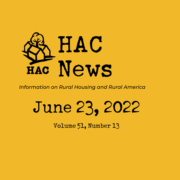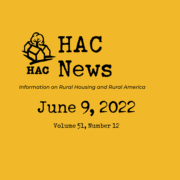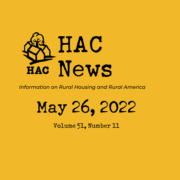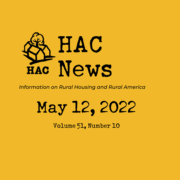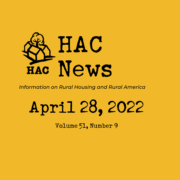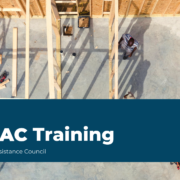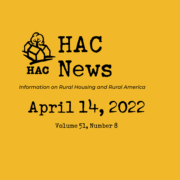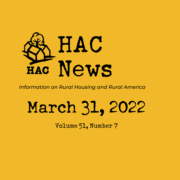HAC News: June 23, 2022
TOP STORIES
House proposes increasing some rural housing funding.
On June 23, the House Appropriations Committee approved a bill to fund USDA for fiscal year 2023, which begins on October 1, 2022. The measure would provide less funding for several rural housing programs than the administration’s budget requested. It would increase the Section 515 rental housing program and the MPR rental preservation program above current levels, but not as much as the administration proposed. It would raise the Rural Community Development Initiative capacity building program from this year’s $6 million to $8 million in FY23 rather than the $12 million USDA requested. The House bill does not adopt USDA’s proposal to “decouple” the Section 521 Rental Assistance program from the Section 515 and 514/516 programs, a change that would allow properties to continue to receive RA after their USDA mortgages end. Like USDA’s budget, the House bill would expand USDA’s pilot program for Native American mortgage lending, which provides funds to Native CDFIs to be reloaned to homebuyers. More details are available on HAC’s website.
House HUD appropriations bill proposes new vouchers and new manufactured housing program.
The House’s draft FY23 HUD funding bill would increase the department’s total funding above both its FY22 level and the amount requested in the administration’s budget. The House Appropriations Committee estimates the bill would fund more than 140,000 new housing vouchers and approximately 5,600 new units for seniors and persons with disabilities. It would provide $500 million for a new Manufactured Housing Improvement and Financing Program to preserve and revitalize manufactured homes and their communities (including pre-1976 mobile homes). It would also set aside $50 million in HOME funds for down payment assistance for first-time, first-generation home buyers. More details are available on HAC’s website. The House Transportation-HUD appropriations subcommittee will hold a markup on June 23 and the full House Appropriations Committee is scheduled to consider the bill on June 30.
Rural setaside included in major new HUD homeless funding initiative.
On June 22 HUD announced a $365 million Initiative for Unsheltered and Rural Homelessness. The funds will be distributed through Continuums of Care and public housing authorities; the application deadline for COCs is October 20. The initiative includes $54.5 million in CoC program grants designated for rural communities, prioritizing places that have high need but a history of being unable to access CoC grants. HUD is using congressionally granted authority to expand the eligible uses for these funds. Another $267.5 million will be targeted to 20-40 communities with high incidences of unsheltered homelessness. Finally, $43 million – approximately 4,000 new incremental vouchers – will be allocated to PHAs with a priority for those that are partners in comprehensive community approaches to solve homelessness. More details are available on HAC’s site.
Inequality widening despite some good news in overall housing markets, says annual study.
Higher interest rates are cooling the demand for market-rate housing and rental construction is increasing, but the affordability crisis is not likely to improve for lower-income households and households of color, according to a new State of the Nation’s Housing 2022 report from the Joint Center for Housing Studies at Harvard University. Purchases of second homes add to the stress in rural areas, JCHS reports, although remote work is less common now than earlier in the pandemic. The paper also notes that the existing housing stock needs investment to meet the demands of the aging population and the threats posed by climate change.
Rural Voices celebrates HAC.
With the title 50 Years of HAC, the latest issue of HAC’s Rural Voices magazine celebrates this milestone anniversary by considering the past 50 years while focusing on the next 50. It revisits some of the many rural communities in which HAC has worked, and it features visions of the future from rural places and rural housing leaders around the country.
RuralSTAT
Seven of 10 rural bankers in the Midwest described their local economy as expanding at the beginning of 2022, while only 6.7% indicated that their local economy was in a modest economic downturn. Source: Survey by Creighton University’s Heider College of Business.
OPPORTUNITIES
USDA offers water system funding.
- The Rural Decentralized Water Systems Grant Program enables nonprofits and Tribal lending institutions to create revolving loan funds or make sub-grants to low-income homeowners who need assistance constructing, refurbishing, or servicing household water well or wastewater systems. This program can be used in places with populations of up to 50,000. Applications are due July 31. For more information, contact Lola Maratita, USDA, 615-714-8883.
- The Revolving Fund Program makes grants to nonprofits to create revolving loan funds to build and improve water and wastewater disposal systems operated by state and local governmental entities, nonprofits, and Tribes in places with populations of 10,000 or less. Applications are due July 31. For more information, contact a local USDA RD office.
Lead hazard reduction and research funds announced.
- HUD’s Lead Hazard Reduction Program funds efforts to identify and control lead-based paint hazards in privately owned rental or owner-occupied housing. Local governments, some state governments, and some Tribes are eligible, and consortium applicants may include nonprofits. Apply by August 8. For more information, contact Yolanda Brown, HUD, 202-903-9576.
- The Lead and Healthy Homes Technical Studies Grant Program funds state, local, and Tribal governments, nonprofit and for-profit entities, and others to conduct studies to improve knowledge of housing-related health and safety hazards and to improve or develop new hazard assessment and control methods. Applications are due July 17. For more information, contact Kofi Berko, Jr., HUD, 202-402-7696.
Creative placemaking grants available from NEA.
Our Town or Nuestra Ciudad, the creative placemaking grants program of the National Endowment for the Arts, offers grants from $25,000 to $150,000 with a 1:1 match requirement. The program supports activities that integrate arts, culture, and design into local efforts to advance local economic, physical, or social outcomes. These projects require a partnership between a nonprofit organization and a local government entity, with one of the partners being a cultural organization. The first part of the application is due August 4. For more information, contact NEA staff, OT@arts.gov.
USDA 502 packaging class offered online.
This upcoming Section 502 Direct Certified Loan Packager Course is full, but the waitlist remains open! HAC will present a virtual five-day advanced course on July 25-29 preparing participants to take the loan packaging certification exam for USDA’s Section 502 direct loan program. This course is for those experienced in utilizing Section 502 and/or other affordable housing mortgage products. The registration fee is $500. For more information, contact HAC staff, registration@ruralhome.org, 202-516-6271.
REGULATIONS AND FEDERAL AGENCIES
Input requested on proposed inspection standards.
Comments are due August 1 on inspection standards that will become part of implementing HUD’s proposed rule on National Standards for the Physical Inspection of Real Estate (NSPIRE), aligning housing quality requirements and inspection standards across programs. HUD is also suggesting changes to its previously proposed list of life-threatening conditions and incorporating them into the NSPIRE inspection standards. For more information, contact Marcel M. Jemio, HUD, 202-708-1112.
HUD to create Tribal advisory committee.
HUD requests comments on its planned creation of a Tribal Intergovernmental Advisory Committee, to be made up of duly elected Tribal leaders representing small, medium, and large federally recognized Tribes. The committee is intended to further communications between HUD and federally recognized Tribes on HUD programs, make recommendations and provide advice to HUD, and encourage peer learning and capacity building among Tribes and non-Tribal entities. Comments are due August 22. For more information, contact Heidi J. Frechette, HUD, 202-402-7598.
Changes in fair lending oversight recommended.
A Government Accountability Office review found problems in the Office of the Comptroller of the Currency’s oversight of national banks’ compliance with fair lending laws. Fair Lending: Opportunities Exist to Enhance OCC’s Oversight of Banks’ Lending Practices explains that OCC made major process changes in 2018, after which the number of fair lending exams of smaller banks dropped sharply. It also used outdated examination guidance, examiners sometimes followed procedures inconsistently, and it did not assess the effects of its process changes. GAO reports that OCC has planned actions to address its recommendations.
Pilot aims to assist farmworkers and employers.
USDA has announced it will work with other federal agencies to develop a pilot program that will address challenges both workers and employers face in using the H-2A visa program and will improve working conditions for both U.S. farmworkers and H-2A workers. USDA plans to consult stakeholders and the United Farm Workers of America as it develops a competitive pilot program for launch ahead of the growing season in early 2023.
PUBLICATIONS AND MEDIA
Interactive graphics show relief aided renters during pandemic but underlying issues remain.
Relief Measures Reduced Hardship for Renters During Pandemic, but Many Still Struggle to Pay Rent in Every State, developed by the Center on Budget and Policy Priorities, shows how relief measures such as the national eviction moratorium and the Emergency Rental Assistance program reduced hardship for renters, but only temporarily. People of color and families with children, as well as low-income residents in the Southeastern U.S., were most likely to fall behind on rent payments.
3D-printed homes to be developed in rural Virginia.
Project Virginia will develop 200 3D-printed homes in Virginia to serve as workforce housing. The first two are being built in Pulaski, in a region seeing high growth for tech jobs. Project developer Alquist 3D anticipates that 3D-printed homes will help ease affordability issues as more jobs move in.
HAC
HAC seeks Loan Officer for Rental Preservation and Housing Specialist – Native American Communities.
- The Loan Officer, Rental Preservation, conducts rental housing lending and preservation technical assistance activities. This work includes marketing, originating, and underwriting new loan transactions in the Loan Fund Division. The Loan Officer also provides hands-on technical assistance to nonprofits that are seeking to acquire and preserve existing USDA-financed (Section 515) rental developments. This position is eligible for telecommuting.
- The Housing Specialist – Native American Communities is responsible for providing direct technical assistance, coaching, and training to tribal communities, tribal housing departments, tribal housing authorities, and nonprofit organizations serving tribal communities. Travel is required. This position is eligible for telecommuting.
Need capital for your affordable housing project?
HAC’s loan fund provides low interest rate loans to support single- and multifamily affordable housing projects for low-income rural residents throughout the U.S. and territories. Capital is available for all types of affordable and mixed-income housing projects, including preservation, new development, farmworker, senior and veteran housing. HAC loan funds can be used for pre-development, site acquisition, site development, construction/rehabilitation and permanent financing. Contact HAC’s loan fund staff at hacloanfund@ruralhome.org, 202-842-8600.
Please note: HAC is not able to offer loans to individuals or families. Borrowers must be nonprofit or for-profit organizations or government entities (including tribes).
Want to reprint a HAC News item?
Please credit the HAC News and provide a link to HAC’s website. Thank you!

